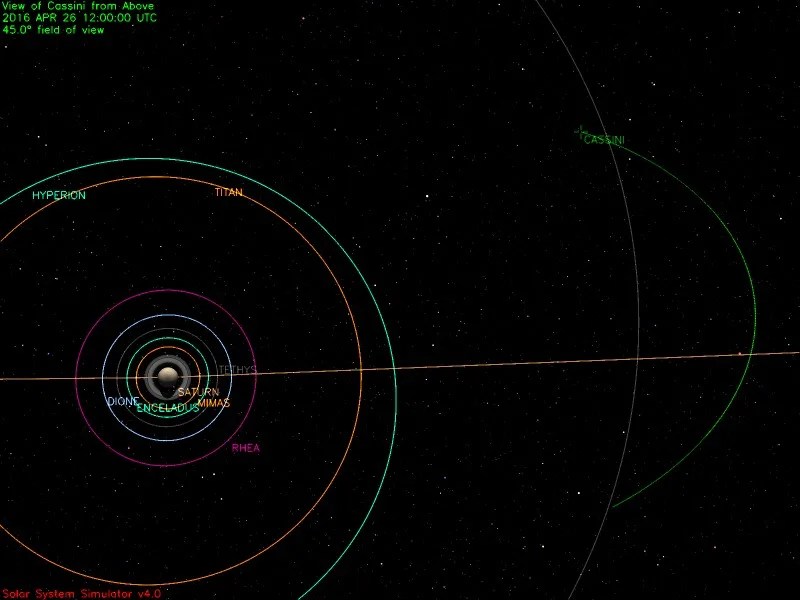5 min read
Cassini is orbiting Saturn with a period of 31.9 days in a plane inclined 28.8 degrees from the planet's equatorial plane. The most recent spacecraft tracking and telemetry data were obtained on April 27, using one of the 34-meter diameter Deep Space Network stations in California. The spacecraft continues to be in an excellent state of health with all of its subsystems operating normally except for the instrument issues described at http://saturn.jpl.nasa.gov/anomalies/ .
For an illustration showing Cassini’s current position as well as some interesting facts, refer to: https://saturn.jpl.nasa.gov/mission/saturn-tour/where-is-cassini-now/ .
Regular visitors will notice that the mission’s newly designed website has gone live. Created to share Cassini’s story with the public like never before, the site features amazing images and visualizations, regular content updates, as well as fresh, vibrant, and engaging descriptions of how Cassini works and what the mission has achieved.
Cassini spent this week continuing on the inbound leg of its Saturn orbit #235. Gathering speed relative to the planet, it passed inward across the orbital distance of Saturn's two-tone moon Iapetus. By week's end, though, the spacecraft had come only within 2.7 million km from the planet.
Meanwhile on Earth, congratulations went out to the US winners of the 2015-16 Cassini Scientist for a Day Essay Contest (schedules for international contest results will vary). More than 1,150 students from 31 states had entered, and the results were determined by dozens of judges who volunteered their time. More information is available here:
https://solarsystem.nasa.gov/kids/scientist-for-a-day/2017-winners/ .
Wednesday, April 20 (DOY 111)
Today, Cassini's Cosmic Dust Analyzer CDA made a nine-hour observation of exogenous dust, grains of material coming into the Saturn system from elsewhere. CDA repeated this observation on Friday, and then again on Saturday.
Thursday, April 21 (DOY 112)
The Imaging Science Subsystem (ISS) led a 90-minute observation in the Titan monitoring campaign, with the Composite Infrared Spectrometer (CIRS) and the Visible and Infrared Mapping Spectrometer (VIMS) participating. Titan was 2.9 million kilometers away. Next, ISS performed a 60-minute observation as part of the satellite orbit campaign, looking for objects close to Saturn. This pair of observations repeated on Saturday as well.
Cassini next turned to point its telescopes to the gas giant, and CIRS and VIMS began mapping Saturn’s atmosphere for 16 hours. This mid-infrared-wavelength observation will help determine temperatures in the upper troposphere and the tropopause.
Friday, April 22 (DOY 113)
The European Geophysical Union (EGU) wrapped up its week-long meeting in Vienna today. The Cassini Project Scientist gave the keynote address on the 2017 Cassini Grand Finale, and there were many other Cassini-related science sessions as well during the week.
A few hours into a routine session with the DSN today, the spacecraft turned away, acting on timed commands that the flight team had uplinked the day before. After Cassini rotated to the prescribed attitude, valves opened to admit pressurized propellents into its main rocket engine, where they ignited on contact, generating about 400 newtons of force. On-board acceleration measurements had the valves close 10.1 seconds later, after the spacecraft's velocity had received a boost of 1.8 meters per second. This Orbit Trim Maneuver (OTM)-447 put the spacecraft on target for its next close encounter with Titan, T-119 on May 6. Following the OTM, Cassini turned back to face Earth and resumed two-way communications and radiometric tracking. Some background on the Navigation team's flight-path control activities such as this may be found here: https://solarsystem.nasa.gov/basics/chapter13-1 .
Saturday, April 23 (DOY 114)
Today marks one year until Cassini starts its Proximal orbits, a series of 22 high-inclination circuits that will bring the spacecraft in between Saturn's rings and atmosphere.
Late in the day, CIRS turned to Saturn's rings and began a ten-hour observation of their sunlit side to obtain thermal-infrared spectra. This will add to studies of ring-particle composition. VIMS and the Ultraviolet Imaging Spectrograph (UVIS) participated in the observation as well.
Sunday, April 24 (DOY 115)
A series of data-handling tests are being carried out on the spacecraft today, directed by realtime commands as well as by commands in the ten-week S94 sequence. The aim of the tests is to be sure that every bit of the most pertinent, valuable science data will be "squeezed out" of the appropriate instruments during the final minutes and seconds of the spacecraft's Grand-Finale plunge into Saturn on Sept. 15, 2017.
Monday, April 25 (DOY 116)
ISS began observing Saturn for 45.5 hours, with CIRS and VIMS riding along. The results will be compiled into a multi-revolution movie of the gas-giant planet.
A remarkable ISS image was featured today. In it the thin strand of Saturn's F ring appears broken, just outside the transparent A ring and Cassini division, whose shadows are visible in the background of Saturn's high-altitude haze. Along the top of the image, the dense B ring is obviously opaque: /resources/17355/ .
Tuesday, April 26 (DOY 117)
New knowledge about the seas and lakes on Saturn's largest, planet-like moon Titan was the subject of a news release today: /news/12897/ .
On five occasions during this week, while Cassini's optical instruments were pointing at or near Saturn, ISS carried out two-minute storm-watch observations. VIMS rode along with two of them.
The Deep Space Network communicated with and tracked Cassini five times again this week, using stations in Spain, Australia and California. A total of 237 individual commands were uplinked, and about 942 megabytes of telemetry data were downlinked and captured at rates as high as 142,201 bits per second.

Cassini position on April 26, 2016







